Social Issues addressed by Sumitomo —Compass for the Future—
Reducing CO2 emissions and achieving a safe working environment through development of excavators, the company’s mainstay products
 Decarbonization
Decarbonization New workstyles
New workstylesSumitomo Construction Machinery, whose core business is the manufacture and sale of hydraulic excavators, asphalt pavers, and other types of construction machinery, supplies state-of-the-art construction machinery in Japan and throughout the world. As construction machinery has changed over time, so has the value that Sumitomo Construction Machinery offers. The company’s initiatives to resolve social issues have two facets: one is “decarbonization” to reduce the CO2 emissions of construction machinery, and the other is “new workstyles” by offering construction machinery that helps keep people working at construction sites safe and secure.
As a global supplier, the company is mindful that it bears an ethical responsibility for the CO2 emissions of its products throughout the world. Whereas, in the past, the quest for greater power tended to be accorded priority over measures to curb pollution, with the passage of time, the environmental impact of diesel engine-equipped construction machinery has been reduced to meet stricter regulations. Furthermore, with a view to achieving carbon neutrality, Sumitomo Construction Machinery was quick to develop a hybrid hydraulic excavator equipped with a motor in addition to an engine, thus contributing to the reduction of CO2 emissions during product use. The company’s efforts in this regard have been acclaimed both in Japan and overseas. For example, the prestigious Conservation Grand Prize was bestowed on the company by the Energy Conservation Center, Japan (ECCJ) in fiscal 2007.
Other initiatives are designed to ensure safety and security of workers at construction sites. Industrial accidents occur at sites where machines and humans work together, and although the number of accidents has decreased over the years, it has not reached zero. To minimize the risk of such industrial accidents, Sumitomo Construction Machinery has been enhancing the image recognition capabilities of the Field View Monitor (FVM) whose functions continue to evolve.
Since the cabs of hydraulic excavators are typically on the left side, the right side and rear tend to become blind spots for the operator. Eager to address this issue, the company developed a function, namely, 270-degree video, captured by three cameras mounted on the rear of the excavator, enabled the operator to check the rear side. This first-generation FVM, was initially offered as an option for hydraulic excavators in 2011 and then, from 2012, FVM was offered as part of the standard equipment of hydraulic excavators for the Japanese market to enhance safety.
With the first-generation FVM capable of displaying 270-degree video of what is happening at the rear of the excavator, which is often a blind spot for the operator, not only in the immediate vicinity of the excavator but also at a distance, the operator can accurately assess the operational environment. So beneficial is this function that it eventually became a de facto industry standard. Nevertheless, since operators must continually check their entire operational environment, they cannot always be looking at the monitor. Therefore, in 2017, the company began offering the newly developed Field View Monitor 2 (FVM2). If a human is detected near the excavator, this second-generation FVM shows an alert on the monitor and simultaneously issues a warning sound. This function is achieved through a combination of image recognition technology and machine learning.
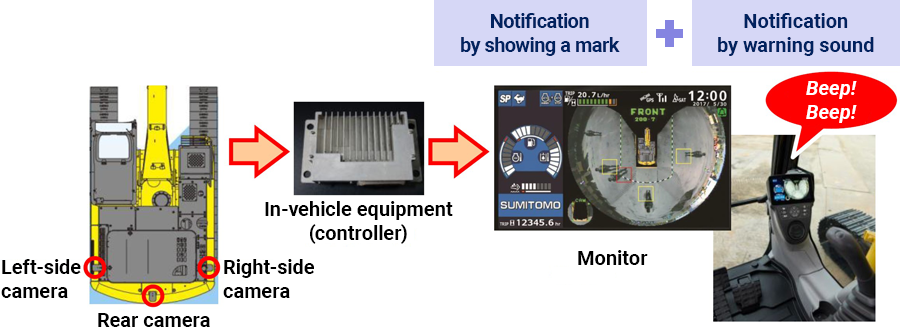
Just as collision mitigation systems have become common for automobiles, so demand for hydraulic excavators and other types of construction machinery equipped with collision mitigation systems has been on the rise. Sumitomo Construction Machinery began offering FVM2+ equipped with a collision mitigation system and notification functions in 2020. If the collision mitigation system detects a person wearing a safety vest within a certain range during turning, reversing, or traveling, the machine automatically reduces speed and stops.

As construction machinery is used for construction and civil engineering, its usage environment is typically harsh. At sites, there are workers, equipment, and piles of dirt. It can be dusty. Moreover, weather conditions change. The system is required to identify humans under various environmental conditions. Therefore, the company adopted a 3D LiDAR (light detection and ranging) sensor, which allows three-dimensional distance measurement using the reflection of laser light. FVM2+ detects the reflection from safety vests worn by workers, making it possible to only respond to humans.
At the same time, to minimize physical stress on the operator, the collision mitigation system is tuned to decelerate before stopping, thus lessening the impact of the stop. For fine-tuning to optimize deceleration to prevent collision without imposing a burden on the operator, the company utilized knowledge gained through interviews with operators. Furthermore, the company also developed a system that monitors the operation of the collision mitigation system in real time. This system is useful for managers and the data obtained are used to create hazard maps that contribute to the data-driven reduction of the risk of industrial accidents.

FVM2+ equipped with a collision mitigation system was registered in NETIS (New Technology Information System) in November 2022. NETIS is a database managed by the Ministry of Land, Infrastructure, Transport and Tourism for sharing cutting-edge technologies developed by the private sector. The fact that users adopting construction machinery equipped with FVM2+ are eligible for points in public works bids has led to enhanced recognition of the valuable contribution the company’s construction machinery equipped with FVM2+ is making to safety and security. Advent of the first-generation FVM underlined Sumitomo Construction Machinery’s longstanding commitment to development and provision of construction machinery supporting safe and secure construction sites. Now, the company is stepping up its efforts to offer progressively higher levels of safety.


Read about initiatives to achieve a low-carbon society, aiming at net-zero greenhouse gas emissions since these emissions are implicated in global warming.
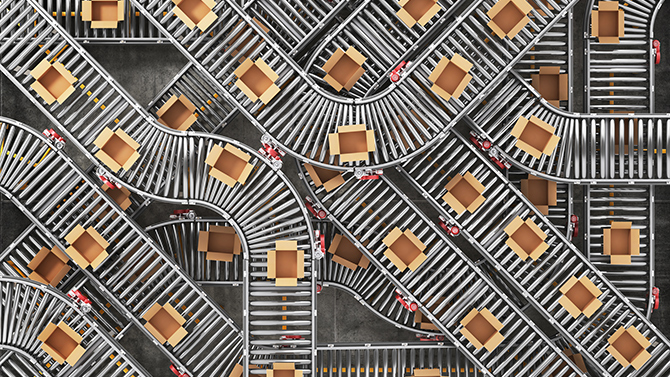
In view of ongoing globalization and the growing complexity of supply chains, companies need to respond appropriately to issues in supply chains.

The pace of workstyle reform is accelerating as the COVID-19 pandemic has prompted numerous companies to embrace novel ways of working.

For companies, the COVID-19 pandemic has brought the crucial importance of employee health into sharp focus.

Accelerating global warming poses serious business risks. Accordingly, companies need to formulate strategies and implement specific countermeasures from a medium- to long-term perspective.
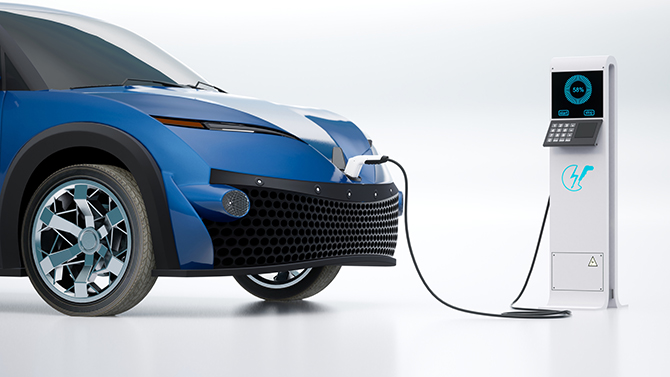
Spurred by efforts to reduce environmental impacts and in line with increasing social needs, replacement of gasoline-powered vehicles with electric vehicles is accelerating.

Vigorous initiatives are afoot to tackle social issues by revitalizing communities and the interpersonal relationships that bind them together.

Poverty persists in contemporary Japan and the existence of child poverty is a grave concern.
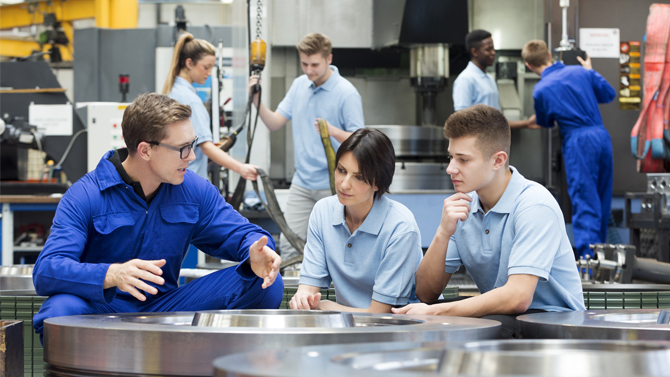
In view of the continuing decline of Japan’s working age population, due to population aging coupled with a low birthrate, development of the next generation is an urgent issue.

The rapid progress in medicine in recent years is largely due to the efforts of not only universities and other research institutions but also of companies to develop cutting-edge technologies.

Numerous initiatives to promote industry and commerce at the regional and community level are underway, involving the use of renewable energy and thus contributing to decarbonization.

One-third of food produced is lost or wasted globally, amounting to about 1.3 billion tons per year. Food loss and waste is a pressing issue in need of a solution.

Companies are addressing a wide range of issues so that people and companies can coexist in harmony with the global environment.

In addition to natural disasters, there are various types of hazards whose nature, incidence and severity are changing with the times. Resilience and flexibility are indispensable in dealing with them.
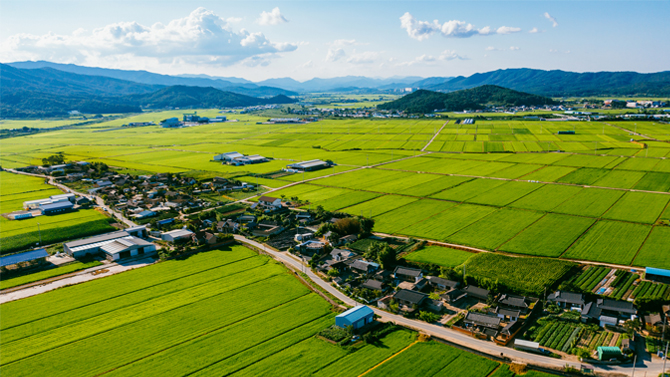
Read about initiatives to achieve sustainable regional revitalization. The attributes and resources that each region can offer are leveraged to strengthen local economies and overcome the problem of population decline.